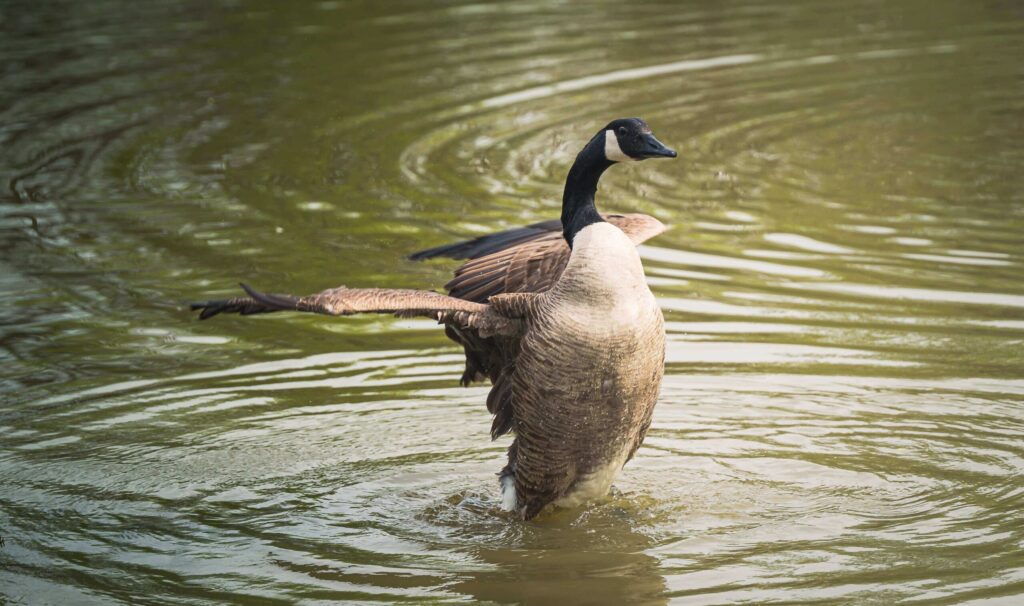Canada Goose (CANG)

Description:
The Canada goose presents a black head and neck with broad white cheek patches extending from the throat to the rear of the eye, forming a white “chinstrap.” Both sexes share this distinctive appearance, though females are often slightly smaller. Body coloring ranges from light gray to dark chocolate brown, and the tail features a U-shaped white band. With an average length of 25-45 inches and weight ranging from 4-15 pounds for males (ganders) and 4-12 pounds for females, this species includes seven recognized subspecies. Variations in size and color are generally influenced by geographical location.
The Seven Sub Species:
- Atlantic Canada Goose: The nominate species of the Canada goose family, the Atlantic Canada Goose was introduced/reintroduced across much of North America in the 1960s and 70s and has since been introduced across Europe.
- Dusky Canada Goose: A west coast subspecies with a range from Oregon into southwestern Alaska, the Dusky Canada Goose is a medium-sized variety.
- Giant Canada Goose: The largest subset of the species, the Giant Canada Goose, was widely believed to have gone extinct in the 1950s. A small subset was found in Minnesota in the 1960s that was used to reintroduce the species across the continent. Today, an estimated 1.5 million of these geese inhabit North America.
- Interior Canada Goose: Also known as Todd’s Goose or Hudson Bay Goose, the Interior Canada Goose is a large subspecies, looking very similar to the Atlantic subset. Its home ranges are from the Hudson Bay south to Florida and west to Louisiana. Most of these subspecies breed around Hudson Bay, giving rise to its name.
- Lesser Canada Goose: Often mistaken for the Cackling Goose, the Lesser Canada Goose is the smallest subspecies of this goose, maxing out around 6 pounds. This subset is often disputed as a largely hybrid species.
- Moffitt’s Canada Goose: Inhabiting the Western U.S. from Montana to California and up into British Columbia, Moffitt’s Canada Goose is the second largest type of Canada goose. There are three distinct populations of Moffitt’s Canada geese: the Pacific Population, Rocky Mountain Population, and Hi-Line Population.
- Vancouver Canada Goose: The Vancouver Canada goose subspecies are mostly non-migratory, with over 98% of individuals spending their entire life in southeastern Alaska and British Columbia.

Distribution and Habitat:
Native to North America, the Canada goose inhabits all 50 U.S. states as well as all Canadian provinces. From coastal areas to the Great Lakes region, these birds have adapted to a wide range of habitats, and large flocks have established permanent residence in many places, called resident geese.
Food Habits:
Primarily herbivorous, Canada geese feed on grasses, seeds, and grains. They adapt well to urban environments, consuming domesticated grasses and agricultural grains when available, hence why many geese are found on local golf courses and near retention ponds.
Population and Migration:
Experiencing more stability in recent decades, populations of Canada geese were dwindling across much of North America in the early 1900s. Many U.S. states and Canadian provinces undertook a concerted effort to introduce/reintroduce the Canada goose. From Ohio to Georgia, efforts were made as part of a broader movement to preserve and protect this iconic species. Overall, estimates count over 3 million resident Canada geese nationwide, with migratory patterns influenced by regional food availability and habitat. Today, there are over 7 million Canada geese in North America, and their numbers continue to grow, symbolizing a triumphant success story of wildlife management. According to the State of The Birds report, Geese are one of the few North American bird species whose populations are increasing year over year! Our 50 Ducks team member, Fred Granitz, was a key figure in introducing Geese into the Georgia ecosystems.
Behavior and Social Structure:
Canada geese exhibit very strong family and pair bonds, often mating for life, and are known to exhibit philopatry (returning to their natal homes to nest). Generally, they lay 2-8 eggs with an incubation period of 25-28 days. They are known for their “honking” call, garnering the nickname “honkers.” When threatened, geese will emit a “hissing” sound as a warning sound. Geese have a much greater nest success rate than ducks, largely due to their size and ability to ward off predators.
The Cackling Goose
Commonly mistaken as a lesser Canada goose, the Cackling goose is a different species entirely. In 2004, the American Ornithological Union separated Cackling geese from the Canada goose species. There are four subsets of Cackling geese.

Graph taken from the State of The Birds report 2022.

Geese in Flight

Map taken from the Cornell Lab of Ornithology
